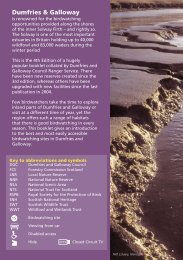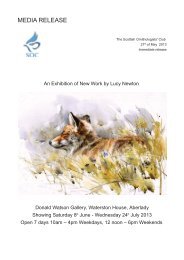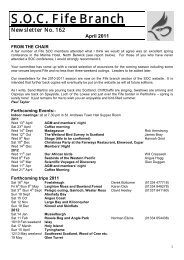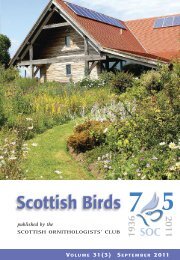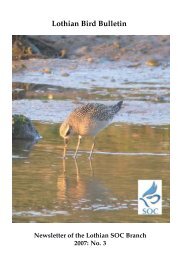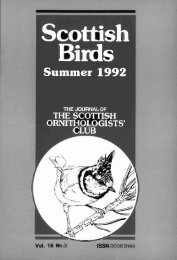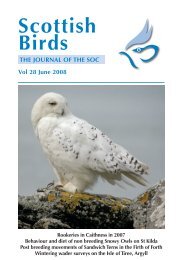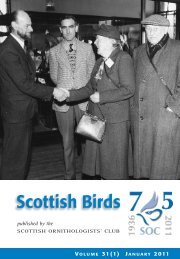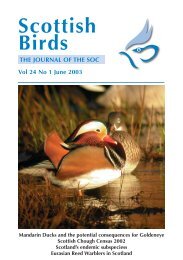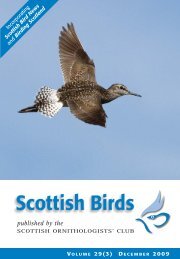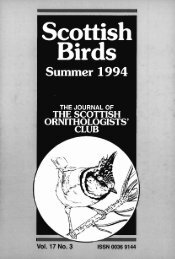V 14 No.4 - The Scottish Ornithologists' Club
V 14 No.4 - The Scottish Ornithologists' Club
V 14 No.4 - The Scottish Ornithologists' Club
You also want an ePaper? Increase the reach of your titles
YUMPU automatically turns print PDFs into web optimized ePapers that Google loves.
1987<br />
Ring Ouzels in SE Scotland 207<br />
TABLE 1 Criteria for judging breeding,'.<br />
Evidence<br />
Number of sites<br />
Pair seen in territory 41<br />
Male singing 40<br />
Nest found 22<br />
Adult(s) with fledged young 17<br />
Single bird alarming <strong>14</strong><br />
Single bird seen 2 9<br />
Total <strong>14</strong>3<br />
When several visits were made to one site<br />
the most positive piece of evidence is<br />
recorded.<br />
No positive signs but bird in suitable<br />
territory in breeding season.<br />
From the 1985 data, 29 valleys showed<br />
evidence of breeding birds, with a total<br />
of <strong>14</strong>0 occupied sites. This figure increased<br />
to <strong>14</strong>3 sites after three more breeding territories<br />
were found in one more valley in<br />
1986. Table 2 summarises these results by<br />
hill ranges.<br />
TABLE 2 Valley systems with breeding Ring<br />
Ouzels.<br />
Valleys<br />
Hill Range with birds/total Territories<br />
Pentlands 218 8<br />
Moorfoots 15/17 66<br />
Lammermuirs 13/17 69<br />
Totals 30/42 <strong>14</strong>3<br />
<strong>The</strong> habitat types are listed in Table 3.<br />
Of the 12 valleys checked where no Ring<br />
Ouzels were found only four, three of which<br />
were in the Pentlands, could be described<br />
as heather moorland. <strong>The</strong> rest were all unsuitable<br />
in appearance, being predominantly<br />
arable. <strong>The</strong> mean height above sea level of<br />
territories was 352rn, with a range between<br />
209m and 533m.<br />
Of the 22 nests found during the<br />
survey, 15 were on the ground, usually<br />
under a clump of heather, on a steep slope<br />
and above a stream. Five nests were on<br />
rocky ledges under heather clumps and two<br />
were in conifers about 1.5rn above the<br />
ground. During the survey 63 young were<br />
ringed.<br />
TABLE 3 Habitat descriptions.<br />
Description><br />
Moorland: heather<br />
Moorland: sheepwalk<br />
Moorland: young conifer<br />
Edge moorland/arable<br />
Edge moorland/mature conifer<br />
Territories<br />
with birds<br />
108<br />
18<br />
<strong>14</strong><br />
> heather, sheepwalk and young conifer refer<br />
to moorland in which ground cover was at least<br />
50% of this type.<br />
Discussion<br />
<strong>The</strong> three hill ranges of southeast Scotland<br />
vary in character. <strong>The</strong> Lammermuirs are<br />
low rolling hills which are still used<br />
predominantly as grouse moor. Heather<br />
cover is extensive, afforestation is significant<br />
only at the eastern edge and<br />
gamekeepers are active. Disturbance is<br />
minimal over much of the range. <strong>The</strong> result<br />
is that most of the main valley systems provide<br />
good Ring Ouzel territory.<br />
<strong>The</strong> Moorfoots are larger, steeper hills<br />
with much more sheepwalk than the Lammermuirs,<br />
although there is still much<br />
heather, especially on the steep valley sides.<br />
Disturbance is minimal and intensity of<br />
gamekeepering varies, depending on<br />
whether or not the area is used extensively<br />
for grouse shooting. Certain areas of the<br />
Moorfoots are now under afforestation.<br />
2



